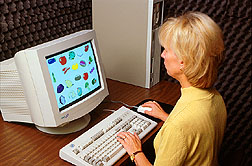Nutrition Studies Get Psyched Over the Internet
|
|
From his computer at the ARS Grand Forks Human Nutrition Research Center in North Dakota, he has collaborated on nutrition studies in China, Guatemala, and New Zealand and in San Francisco, California, and Brownsville, Texas.
Penland sends computerized psychological tests to study leaders, receives raw data that he scores and analyzes in his lab, and returns the results—all electronically. He even troubleshoots problems at the study site from his computer, using a remote control program originally developed by software companies for use by technical support staffs.
"You can observe how the user operates the program, then take control and have the user observe how you do it," notes Penland. "It's a very useful device for training."
Nutrition researchers know that peoples' nutritional status can affect their behavior and learning. But only a handful of psychologists are involved in nutrition studies. So, over the last decade, Penland has computerized a battery of tasks for testing the cognitive and motor functions of study volunteers—young and old.
Unlike other computerized tests, which are limited in scope, Penland's can cover the gamut of psychological functions. They include tests of fine and gross motor skills, eye-hand coordination, sustained attention, spatial and verbal memory, visual perception, concept formation, and abstract reasoning.
And it's a totally flexible system.
"We select the tasks we want to use in a given study. We can alter them to suit the study or incorporate new tasks," says Penland. For instance, in the Guatemalan study, the instructions needed shortening.
"The children were taking 2 hours to do the 1-hour test. They spent half of the time trying to read the instructions on the screen," says study leader Lindsay Allen, professor of nutrition at the University of California at Davis. The instructions were originally translated into Spanish for the Brownsville study by Penland's assistant, Allison Pate. However, says Allen, the Guatemalan children she studies don't start school until age 7 or older. They have limited access to books, less to TV, and no access to computers, "so they are behind the Brownsville children," she says.
No problem. Allen and the Guatemalan psychologists studying the children rewrote the instructions to make them "really crisp and uncomplicated," she says. They were sent to Penland's laboratory via the Internet, where he substituted the new instructions into the test battery and sent it back to Guatemala.
The findings: Children deficient in vitamin B12 took longer to respond to perception and memory tasks than those with normal B12 status, although their answers were no less accurate. Allen plans a follow-up study to see if B12 supplementation will reduce this time delay. She says Penland's system "is a very impressive method of putting together all the tests I need in a way that is culture free."
Zinc and Speed of Recall
Between 1994 and 1996, Penland collaborated with Harold Sandstead at the University of Texas Medical Branch in Galveston on a study of 1,400 school children in China.
"It's the first time anything like this has been done," says Sandstead, a professor who also led the Brownsville study. "It would take forever to administer the tests by hand. And the computer does not vary how it administers the tasks; it's much more standardized."
Data showed that poor, urban Chinese children improved in perception, memory, and reasoning skills after getting extra zinc or zinc plus other essential vitamins and minerals. Sandstead says he is seeking funding to determine which vitamin and mineral combinations work best and how often they need to be given. "These are the practical aspects a government needs to know before beginning a remedial program," he says.
At ARS' Western Human Nutrition Research Center, now located in Davis, California, Mary Kretsch and colleagues experienced some incompatibility when loading the software onto their portable computers. Penland's programmer, Larry Siu, made the necessary modifications.
A nutritional scientist, Kretsch went on to test a host of psychological functions in eight men who consumed both low- and adequate-zinc diets. About 3 weeks into the low-zinc diet, says Kretsch, all eight were slower to identify words they had seen earlier. But by the end of that diet, their recognition times speeded up.
"It looks like people can adapt to a low-zinc diet," she says, noting that the 5 milligrams of daily zinc provided by this diet may not be low enough to have a permanent effect. While it is one-third the U.S. recommended intake for men, it is equal to the new World Health Organization recommendation.
Penland says each study takes about 5 percent of his time because he doesn't have to personally administer the tests. He generally travels to the site to train those who will administer them.
"There's a benefit to meeting the test givers face to face," he adds, "but we can do it blind"—as he did in the Guatemalan study and part of the China study. He says new video conferencing technology will soon allow him to do the training from his laboratory in Grand Forks.
His laboratory is now putting the finishing touches on a Windows version of the test battery. It will be capable of incorporating video, sound, and external devices such as an electroencephalogram so that researchers can measure volunteers' electrophysiological responses to tasks on the screen.
"The tests will always be changing," says Penland. "The benefit is that they're flexible."—By Judy McBride, Agricultural Research Service Information Staff.
This research is part of Human Nutrition, an ARS National Program (#107) described on the World Wide Web at http://www.nps.ars.usda.gov/programs/appvs.htm.
James G. Penland is at the USDA-ARS Grand Forks Human Nutrition Research Center, P.O. Box 9034, University Station, Grand Forks, ND, 58202-9034; phone (701) 795-8471, fax (701) 795-8220.
"Nutrition Studies Get Psyched Over the Internet" was published in the November 1999 issue of Agricultural Research magazine.







